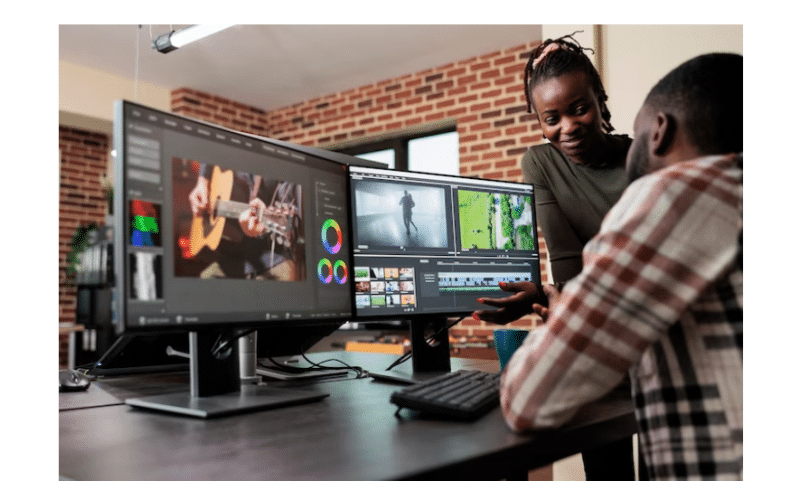What Is Image Editing Software?
Image editing software is employed to edit or improve digital images. Software in this category can be as simple as free apps that can add simple effects or as complex as programs that are used by professional photographers. Many of these programs’ features are modeled after hand-editing methods carried out in a dark room.
Typically, an image editing program works with digital camera-taken images that are then imported or uploaded to the program. Therefore, many photographers are choosing to use tablets or even smartphones instead of conventional desktops or laptops to use their photo editing software programs as touchscreen technology and wireless file transfer become more advanced.
How Does Image Editing Software Work?
Using photo editing software, many aspects of a picture can be changed, frequently down to the pixel level. Several of these techniques can be carried out by the majority of simple photo editing software, including:
- Adjusting the intensity levels all across the color spectrum is color balance.
- The photo’s exposure controls how much light or brightness is used.
- The amount of noise or grain reveals the degree of detail or pixel distortion.
- Saturation, which denotes how vividly all colors appear.
- cropping, which modifies the image’s dimensions.
- Using burning or dodging to change the contrast between light and dark.
Users of more sophisticated programs can also carry out tasks like background removal, healing, cloning, selective adjustments, and layering. Additional artistic features like brush and pencil strokes, textures, and 3D design are frequently included in these advanced programs.
Best 18 Free Image Editing Software
#1. Lightroom Classic Image Editing Software
Lightroom Classic is the top workflow software for professional photographers, offering excellent photo management, organization, and correction tools. It includes features like printing, soft-proofing, tethered shooting, and plug-in support.
However, it lacks features for amateurs and hobbyists, such as video-editing tools and learning content. Therefore Adobe’s cutting-edge imaging technology and unmatched workflow tools make it a popular choice for photographers.
#2. Adobe Photoshop
Photoshop is a powerful image-editing software designed for professional designers and photographers. It offers advanced features like AI-powered Neural filters, layers, masking, text, shapes, gradients, and filters.
Furthermore, with a wealth of third-party plug-ins, Photoshop is ideal for serious image editing enthusiasts. Its interface has become more manageable, with a clear Home screen, hover-over help tips, and a persistent search box. However, it requires a subscription fee to continue using it.
#3. Capture One Image Editing Software
Capture One offers adjustments, local edit tools, layers, and advanced color grading. On the other hand, it trails Lightroom in some workflow abilities, such as face recognition and geotagging. Designed for professional photographers, Capture One has strong support for tethered shooting, collaboration features, and an iPad app for editing on the go. It is priced like a professional application and offers both a subscription and a one-time purchase.
However, the interface can be complex, especially with layers, and lacks face recognition for organization. Capture One is expensive, with a monthly subscription costing $24 per month.
#4. Corel PaintShop Pro Image Editing Software
PaintShop Pro is a budget-conscious image editor that offers advanced AI tools like Portrait Mode, Background Replacement, and Style Transfer. It supports text, brushes, patterns, and painting tools on both raster and vector images, as well as creative effects and filters.
Additionally, it also supports raw camera file support, mask selection, scripts, tone curves, layers, and plug-ins, making it suitable for both amateur and professional designers and photographers.
Furthermore, PaintShop Pro offers deep image editing capabilities, AI fixes, and effects, making it an excellent choice for those looking to save on Adobe’s collaboration and proprietary tools.
#5. PhotoWorks Image Editing Software
PhotoWorks is an affordable PC photo editor with a minimalist interface, content-aware artificial intelligence, and features like color grading, background change, and photo montage tools. It offers basic editing tools like color and tone enhancement and cropping.
Additionally, the program supports RAW formats, has a non-destructive workflow, and features portrait retouching powered by AI filters and 3D LUT presets. However, it has no Mac version yet. Overall, PhotoWorks is a top-notch tool for editing portraits and landscapes.
#6. Adobe Lightroom
Lightroom, Photoshop’s brother, is a powerful photo editing software with a sleek interface, face detection, filters, and color correction presets. Additionally, it offers a convenient file manager panel and a monthly subscription for hardware-related demands.
However, it may be slow and require a monthly subscription for hardware. Overall, Lightroom is a top choice for PC photo editing.
#7. GIMP Image Editing Software
GIMP is a powerful open-source photo editing software for Windows, Mac, and Linux. It offers various tools for color enhancement, cropping, noise reduction, and layer manipulation. Although it is completely free, it can be buggy and slow, and it has limited features for professionals. However, it supports almost any graphic format and can be expanded through plugins.
#8. PhotoDirector
PhotoDirector is a user-friendly software for organizing, enhancing, and editing photos. It offers lens correction, layer support, and 360-degree image creation. Additionally, it has good value for money and a good overall score.
#9. ON1 Photo Image Editing Software
Photo is a non-destructive RAW editing software with high-end features like smart color correction, face retouching, lens correction presets, and filters. Additionally, it supports various cameras, supports HD merging, and panorama stitching, and has a non-destructive workflow. However, it requires a powerful PC for optimal performance.
#10. Polarr
Polarr is a user-friendly picture editor with a convenient interface, extensive filters, and color and lighting adjustments. It is available as a free desktop and web-based application, but it lacks support for RAW formats and can be buggy at times.
#11. Luminar AI Image Editing Software
Luminar AI is a popular photo editing app for PC, offering AI-driven tools for fast and intuitive editing. It includes basic and advanced tools, effects, and filters. Additionally, it has a customizable workspace, an efficient organizing system, support for RAW formats, and enhancement filters for various photo genres. However, it has high system requirements and limited tools for portrait retouching.
#12. Movavi Picverse Image Editing Software
Movi Picverse is a photo editing software for PC and Mac, offering a wide range of tools for beginners. It is easy to use, supports popular formats, has low system requirements, and has a vast library of filters. However, it lacks pro-level tools and has limited functionality in the free trial.
#13. PortraitPro Image Editing Software
Portrait Pro is a standalone editor and plugin for Photoshop and Lightroom, focusing on retouching portraits using facial recognition. It offers fast and efficient retouching, with automatic presets and manual adjustments. It is user-friendly and easy to navigate, but there is a trial version with a watermark.
#14. PhotoDiva
PhotoDiva is an AI-powered portrait editor with a freemium distribution model. It offers various tools for beautifying pictures, including blemish removal and digital makeup. Additionally, it uses facial feature recognition technology to eliminate manual selection and brushing, resulting in automatic effects. However, the free version has limited functionality.
#15. Canva
Canva is a versatile tool for marketers and graphic artists, offering pre-made templates, photo collages, and various photo editing tools. It supports multiple file types and allows users to order products directly from the interface. Additionally, Canva also offers cloud storage for edited photos and allows users to share and store graphic design projects.
With thousands of templates and expanded options for Pro users, Canva is completely free, with pricing options of $119.99 per year for a base plan or $30 per month per person for the Enterprise plan.
#16. Exposure X7
Exposure X7 is a standalone software that offers a complete workflow and image editing tool for organizing, editing, and sharing photos. It supports layers, blur, overlays, and preset effects, similar to Adobe Lightroom. It is fast, efficient, and compatible with Adobe Photoshop and Lightroom. Pricing starts at $30 for a 30-day trial, with a one-time payment of $129 or $149 depending on the bundle.
#17. PicMonkey
PicMonkey, a subscription-based service by Shutterstock, provides professionally developed templates for creating social media posts, flyers, logos, and banners. It offers access to stock photography, video footage, customizable graphic elements, vector graphics, and a large font library for unique digital design projects.
Additionally, PicMonkey is designed for users with limited design experience and includes a mobile app for iPhone and Android. It offers a “brand kit” with logos, custom fonts, and colors.
#18. Pixlr Editor
Pixlr is a free photo editor with various effects and editing capabilities, including layers, visual effects, overlays, color replacement, cropping, resizing, and preset filters. It supports Adobe Photoshop PSD files and can export them as JPG or PNG. Pixlr is suitable for beginners and offers a free plan or a premium subscription.
How Can I Edit Pictures On My Laptop For Free?
You can edit pictures on your laptop by following the steps below:
- Navigate to photos.google.com on your computer.
- Open the picture you want to change.
- At the top right, click Edit
.
- Click on the suggestion name to make the suggested edit.
- For example, click Enhance
.
- For example, click Enhance
- Click the suggestion name again to reverse the changes.
- Click Save when you’re finished.
Which App Is Best For Photo Editing?
The best photo editing software is Adobe Lightroom. It has a wide range of tools for editing, enhancing, and touch-ups. You can save time and money by streamlining your workflow with presets. Additionally, it’s a useful tool for organizing photos.
Is There A Free Alternative To Photoshop?
Pixlr is a powerful browser-based tool created by AutoDesk, offering a wide range of tools like blur, sharpen, noise, levels, and curves. It also includes a toolbox similar to GIMP’s, including stamp tools, healing tools, brushes, and fills. Additionally, Pixlr is accessible on any platform, supports layering and blending, and has a customizable interface. However, it requires a flash download, lacks pen tool support, and lacks guides and rulers.
How Do I Edit Photos On My PC?
Step 1: Go to the PixStudio website at https://ps.wondershare.com and select “Start Design Now.”
Step 2: Decide on the final design you want to have. Try clicking “Remove Now” after you’ve uploaded the picture to get the background off.
Step 3: Click “Background” on the left to change the background color or choose an elaborately detailed one at your leisure. Additionally, you can add effects to your image to make it look even prettier.
Step 4: Get the final image by downloading the photo for free.
How Do I Edit A JPEG Image?
There are various methods to edit JPEG images without Photoshop, but some may be more challenging and require additional software. GIMP is a powerful tool with layers and support for RAW images. Meanwhile, online tools like JPEGmini and JPEG Editor are popular for editing JPEG images, with JPEGmini being a free option and JPEG Editor being a paid option with more features but more difficulty.
Does Photo Editing Need A Lot Of RAM?
Photo editing software requires significant memory, depending on the complexity and size of the images being processed. A higher RAM is generally recommended for better performance, especially when working with large images or performing complex edits.
Adobe Photoshop recommends 16GB or more for optimal performance, while other software may have different requirements. Therefore, ensure that your computer has the necessary RAM to perform photo editing tasks efficiently and smoothly.
What Computer Do Most Photographers Use?
The iMac 24″ (2021) is the best PC for photographers, featuring the Apple M1 System on a Chip, graphics processors, memory, and a compact 11.5-inch screen. Additionally, the MacBook Pro 16-Inch (2021) is a beautiful, resource-intensive laptop suitable for photographers and photo editors.
What Laptop Specs Do I Need For Photo Editing?
- Intel I7 or AMD Ryzen 7 processor
- 16 GB of Ram
- 1080 (Full HD) monitor,
- 5500 GB SSD Minimum
- At least 2 USB ports
Additional options that would improve the usability of a laptop used for photo editing include:
- Headphone jack (I’m looking at you, Apple)
- 2.7k, or 4k Monitor with full sRGB spectrum
- A machine with a dedicated graphics card
- 1TB SSD storage
- As many USB ports as possible, with at least one USB C port
- Ethernet input
- HDMI input
- SD card reader
- An external mouse, keyboard, and additional ergonomic supports
The Best Online Image Editing Software
#1. Pixlr
Pixlr is an online photo editor without an account, offering various free features. It allows resizing, removing unwanted subjects, replacing colors, blurring, and creating bokeh effects. Users can also register for additional features.
#2. Fotor
Fotor is an online photo-editing tool that allows users to add filters, effects, crop, adjust exposure, highlights, contrast, and shadows, and edit multiple pictures simultaneously. Although ads may be irritating, they’re suitable for basic edits. Users can also use the batch editing feature to edit multiple pictures simultaneously.
#3. PicsArt
PicsArt is a simple tool for editing photos and videos without complex software. It allows for blending, adding effects like noise and HDR, and creating artsy edits. Additionally, users can adjust hue, saturation, temperature, clarity, and brightness, and remove unwanted parts using the Erase tool. To use PicsArt, users must register before using it.
#4. BeFunky
BeFunky is a powerful online photo editing software with free features like blurring edges, softening, red-eye reduction, cropping, resizing, and rotation. It also allows you to add frames, quirky styles, and overlays to enhance your photos. Additionally, it offers cropping, resizing, and rotation options.
Why Are Quality Photos Important on Instagram?
FREE PORTFOLIO WEBSITE: Top Rated Portfolio for Writers, Photographers & Free Tips
BEST PHOTOGRAMMETRY SOFTWARE IN 2023(Updated)






